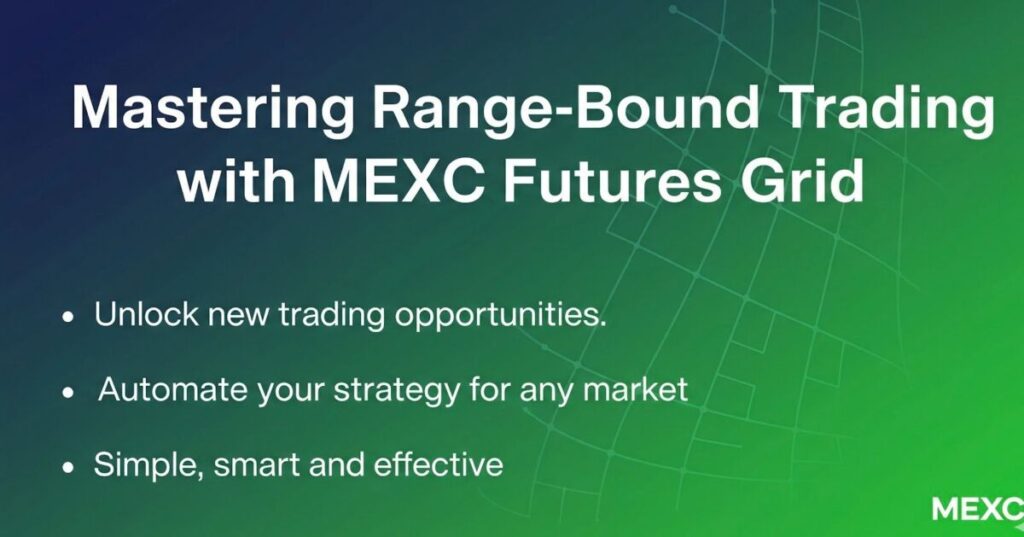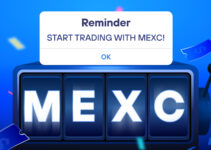
Cryptocurrency futures trading can be exhilarating when markets trend hard. But what happens when they don’t? When prices simply oscillate up and down, sideways, bouncing between support and resistance levels? That’s where range-bound strategies come in. They offer a disciplined way to profit in markets with no clear direction. And if you use them well, tools like MEXC’s Futures Grid Bot can make this approach accessible, systematic, and efficient.
In this guide, we’ll cover what range-bound trading is, when it works best, how to configure the Futures Grid bot at MEXC for range strategies, risk and money management, and common pitfalls to avoid.
1.What is Range Bound Trading?
At its core, range-bound trading means capitalizing on price movements between defined upper and lower levels, resistance and support. Instead of trying to catch a trend, you expect price to reverse at the edges of a range and trade accordingly. Buy low (near support), sell high (near resistance), and repeat until a breakout signals a new trend.
Some key characteristics:
- Price touches or comes close to the same support and resistance levels multiple times without breaking through.
- The market tends to be less volatile than trending phases (but volatility still matters to your grid settings).
- Indicators like the Average Directional Index (ADX) are often low, implying the absence of strong trend momentum.
- You may see volume patterns that help confirm reversals: low volume on approaches to resistance or support, and confirmation candles when bouncing.
Range trading works best in markets lacking strong up-or-down bias, during consolidations, after sharp moves, or when external forces keep pull/push in balance.
2.Why MEXC’s Futures Grid Bot is a Good Fit for Range-Bound Strategies
MEXC has built features in its Futures Grid Bot well suited for this type of trading. Here are a few of its strengths:
- Neutral Grid Mode The bot offers a Neutral grid option, which is designed exactly for markets without a clear trend, the kind where price is bouncing between levels.
- Small Entry Size Threshold You can start with as little as 10 USDT. This low barrier lets you experiment in real markets without risking large capital.
- Multiple Grid Bots MEXC allows users to run up to 30 grid bots simultaneously, letting you spread risk, test different ranges, or manage multiple trading pairs at once.
- Flexible Parameters You can set price range, grid count, leverage, and choose when the bot activates. All these levers are vital when you want precision in range trades.
- Hedge Mode & Cross Margin Mode The bot operates in hedge mode and cross margin mode, which helps manage positions more safely in unstable or oscillating markets.
3.Setting Up a Range Bound Strategy with MEXC Futures Grid Bot
Here’s a step-by-step walkthrough to set up a range-bound grid strategy using MEXC:
| S/N | Step | What to do | Why it matters |
| 1 | Identify a Range-Bound Market | Watch a futures pair over several sessions. Check if price has bounced between visible highs and lows without breaking through. Use indicators (ADX < ~25, RSI oscillating) and volume patterns to confirm. | Ensures you don’t deploy a range strategy in a trending market, where it will often lose. |
| 2 | Choose Direction = Neutral | In MEXC’s Grid Bot, select the Neutral grid mode. | This mode assumes no directional bias, ideal for ranges. |
| 3 | Set Price Range (Upper & Lower Limits) | Mark recent resistance and support levels. Make sure your upper boundary is just below resistance and lower boundary just above support to avoid constant triggers and whipsaws. | A tight but realistic range reduces wasted trades and overtrading. |
| 4 | Determine Grid Count and Interval | Choose a number of grids (e.g. 20-50) and evenly spread them across your selected range. Smaller intervals give more frequent trades but smaller profit per trade. Larger intervals, fewer but higher profits. | Grid configuration defines how many trades you make and how often; balance is key |
| 5 | Set Leverage Conservatively | Mark recent resistance and support levels. Make sure your upper boundary is just below resistance and lower boundary just above support to avoid constant triggers | A tight but realistic range reduces wasted trades and overtrading. |
| 6 | Activate Bot and Monitor | You may do this immediately or set a trigger price. Also observe how price behaves at the boundaries: if it’s repeatedly touching and rejecting, your range is valid. | Monitoring ensures you can adapt or stop early if conditions change. |
4.Risk & Money Management
Range strategies are less risky than trend following, in some respects, but they come with their own challenges. Here’s how to protect your capital:
- Set Stop-Loss / Exit Rules Place protective exits just outside your upper and lower boundaries. If price breaks through repeatedly, it likely indicates a breakout — better to exit than to suffer beyond your risk tolerance.
- Limit Leverage Conservative leverage helps. Even though MEXC allows leveraged grid strategies, in range trading, tight losses and frequent trades require you to avoid blowing up a position.
- Position Size & Capital Allocation Don’t allocate all capital to one grid bot or one trading pair. Spread risk across a few pairs or multiple bots where possible.
- Watch for Breakouts Range periods don’t last forever. Signals like increasing volume, ADX rising, or candlesticks closing beyond resistance/support may suggest a breakout. Be ready to stop or switch strategies.
- Adjust to Volatility Volatile price swings widen ranges. Use indicators like Average True Range (ATR) to measure volatility. When volatility increases, you may need wider grids or fewer grids to avoid being over-fired by noise. When volatility drops, tighten the grid parameters.
5.Example: Applying the Strategy
Imagine a scenario with a futures contract, say BTC-USDT Futures, which has been trading between $30,000 and $32,000 over the past few days. Price keeps bouncing off those levels. Let’s build a simple range strategy:
- Support: $30,000
- Resistance: $32,000
- Choose Neutral Grid Mode
- Set 20 grids: price interval = 2,000 ÷ 20 = $100 between grid levels
- Use low leverage, e.g. 2×
- Allocate $500 to the bot
- Set stop-loss exit if price breaks above $32,500 or drops below $29,500 (just outside your range)
With this setup, each time the price moves up $100 you sell a small portion; when it moves down $100 you buy back. Over many oscillations, profits accumulate. If a breakout occurs, your stop-loss helps limit downside.
6.Indicators & Tools to Help
To make this strategy more reliable, combine the grid bot with supporting indicators:
- ADX (Average Directional Index): Helps quantify trend strength. Low ADX means more likely range-bound.
- RSI (Relative Strength Index), Stochastics: To see overbought/oversold at extremes. Good confirmation at resistance or support edges.
- ATR: Helps size your grid and stop-loss. Smaller ATR → tighter grids; larger ATR → wider.
- Volume analysis: Price touching boundary with low volume often weak; bounce backed by volume tends to be more reliable.
- Multi-timeframe analysis: Check higher timeframe charts to verify the range defined on your working chart. Higher timeframe resistance/support are sturdier.
7.Real World Tips & Best Practices
Here are suggestions that seasoned traders find helpful, especially on platforms like MEXC:
- Start with one or two grid bots only until you get a feel. It’s tempting to run many, but tracking multiple bots, ranges, and support/resistance across multiple pairs can get overwhelming.
- Backtest your range historically: check past chart behavior preceding your start. If price has respected your support/resistance several times, your range is more likely to hold.
- Adjust for news or events: Sudden macro news, regulatory statements, or network/upgrades in crypto can disrupt ranges. It may be safer to stop bots ahead of predictable events.
- Keep an eye on funding rates / costs: In futures, holding long/short positions over time incurs funding fees; those can eat profits if you’re not careful. When using high leverage, costs matter.
- Record your results: Log each bot, entry range, profits, loss, reasons for exiting. Over time, you’ll see which parameters perform best for specific pairs or market types.
8.When Range Bound Strategies Are Not the Right Choice
Knowing when not to use a range strategy is just as important:
- When a clear trend has formed already. If price is consistently making higher highs or lower lows, pinning grid trades becomes riskier.
- When volatility becomes too high or erratic. Sudden large swings can blow through your grid bounds.
- Low liquidity in the pair. Less liquid futures can have large spreads, slippage, or delayed fills.
- When funding rates or fees are too high relative to your expected gain per oscillation.
9.Conclusion
Range bound futures trading can be an excellent strategy for many traders when used with discipline, good setup, and sound risk control. The MEXC Futures Grid Bot offers genuinely useful tools: neutral mode, flexible parameters, and low entry size. When markets are quiet or moving sideways, that’s often when range strategies shine. If you want to try this out, begin with small capital, test ranges carefully, use supporting indicators, and always have an exit plan for breakouts. Over time, you’ll build the instincts to know when a range is stable and when it’s about to shift.
Disclaimer: This content is for educational and reference purposes only and does not constitute any investment advice. Digital asset investments carry high risk. Please evaluate carefully and assume full responsibility for your own decisions.
Join MEXC and Get up to $10,000 Bonus!


